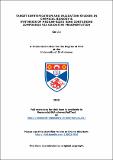Files in this item
Target identification and validation studies in chemical biology & Synthesis of medium-sized ring containing compounds via oxidative fragmentation
Item metadata
| dc.contributor.advisor | Westwood, Nicholas James | |
| dc.contributor.author | Liu, Gu | |
| dc.coverage.spatial | 235 | en_US |
| dc.date.accessioned | 2010-09-13T13:01:42Z | |
| dc.date.available | 2010-09-13T13:01:42Z | |
| dc.date.issued | 2010-06-23 | |
| dc.identifier | uk.bl.ethos.552389 | |
| dc.identifier.uri | https://hdl.handle.net/10023/986 | |
| dc.description.abstract | Part I of this thesis describes the development of bioactive small molecules of relevance to the study of the apicomlexan parasite Toxoplasma gondii into useful chemical tools. The research includes the target identification and validation studies, using both chemical and biological methods. Chapter 1 provides an overview of chemical genetics with a particular emphasis on methods for the identification of the protein targets of bioactive small molecules. The concept of biochemical protein target identification techniques was introduced with a detailed discussion of interesting applications from the literature. Chapter 2 focuses on the development of a tetrahydro-β-carboline based lead molecule into a chemical tool through target identification studies. The structure activity relationship (SAR) data associated with this core structure, the design of a chemical inducer of dimerisation (CID) and the synthesis of this CID are discussed in detail. Chapter 3 described work done to identify the potential protein target(s) of Conoidin A. Experiments to assess whether Conoidin A can inhibit a proposed target in vitro are also included. Further optimisation of this structural class to develop more potent inhibitors is discussed in the second part of this chapter. Part II of this thesis describes the development of methods for the synthesis of medium-sized ring containing compounds using oxidative fragmentation and rearrangement strategies. Chapter 5 provides an overview of the existing oxidative fragmentation methodology, with an emphasis on the use of oxidative fragmentation reactions for the synthesis of medium-sized ring systems (8-11 ring atoms). Chapter 6 focuses on using the established oxidative fragmentation method in the oxizino carbazolone system to investigate the diasteroselectivity of this reaction. Possible mechanisms for this transformation are investigated and discussed using both chemical and computational methods. An interesting rearrangement reaction has also been observed during this study. Chapter 7 focuses on developing an asymmetric oxidative fragmentation method, for use in the diazabenz[e]aceathrylenes system. Asymmetric oxidative fragmentation reactions using [Ru(pybox)(pydic)] catalysts are discussed. Attempts to optimise the enantiomeric excesses of the reaction by varying reaction conditions and substituents in the substrate are also included. | en_US |
| dc.language.iso | en | en_US |
| dc.publisher | University of St Andrews | |
| dc.subject | Chemical biology | en_US |
| dc.subject | Target identification | en_US |
| dc.subject | Target validation | en_US |
| dc.subject | Medium-sized ring | en_US |
| dc.subject | Oxidative fragmentation | en_US |
| dc.subject | Oxidative rearrangment | en_US |
| dc.subject | Peroxiredoxin | en_US |
| dc.subject | Toxoplasma gondii | en_US |
| dc.subject.lcc | QP550.L5 | |
| dc.subject.lcsh | Bioorganic chemistry | en_US |
| dc.subject.lcsh | Biochemical genetics | en_US |
| dc.subject.lcsh | Bioactive compounds | en_US |
| dc.subject.lcsh | Ring formation (Chemistry) | en_US |
| dc.subject.lcsh | Fragmentation reactions | en_US |
| dc.subject.lcsh | Rearrangements (Chemistry) | en_US |
| dc.title | Target identification and validation studies in chemical biology & Synthesis of medium-sized ring containing compounds via oxidative fragmentation | en_US |
| dc.type | Thesis | en_US |
| dc.type.qualificationlevel | Doctoral | en_US |
| dc.type.qualificationname | PhD Doctor of Philosophy | en_US |
| dc.publisher.institution | The University of St Andrews | en_US |
This item appears in the following Collection(s)
Items in the St Andrews Research Repository are protected by copyright, with all rights reserved, unless otherwise indicated.

